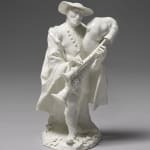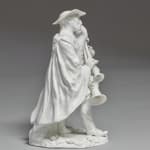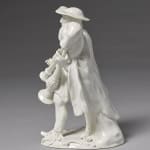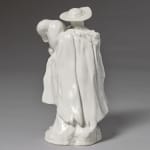



An Extremely Rare Bow Figure of a Bagpiper, Circa 1750-1752
Further images
An Extremely Rare Bow Figure of a Bagpiper wearing a billowing fur trimmed cloak over a buttoned shirt and waistcoat with trousers and squared toed laced shoes with a wide brimmed hat over his combed hair which covers the nape of his neck. Standing on an elliptical base with applied flowers, his left leg leaning against a stump, he plays an Italian double reeded zampogna with a furrowed expression, lips pursed around the mouthpiece of the blowpipe while holding the bag over his left shoulder, fingers grasped around the short chanter.
The figure was first adapted by Meissen from a print engraved by Jean Daullé (1703-1763) in 1739 after Jacques Dumont 'le Romain' (1701-1781), The Bagpiper. See an example in the National Gallery of Art, Washington (2014.37.6 ).
Kaendler’s taxa records of July and August 1741 mention: ‘einen alten Mann nach der Zeichnung, wie er auf einen Dudelsack spielet’ [an old man playing a bagpipe based on a drawing]… ‘1 alter Mann mit sehr abentheuerlichen Habit samt einem curiosen Dudel Sack, darauff er spielt 4 Thlr’ [an old man with an adventurous outfit playing curious bag-pipes 4 Thalers].
Press-moulded with hand-modelled details, this Bow figure is extremely rare. Known examples include:
1. An example previously thought to be Mennecy in the British Museum, London (Franks.360) and discussed in Aileen Dawson, A Catalogue of French Porcelain in The British Museum (1994), no. 298, p. 407.
2. An example in the Katz Collection in the Museum of Fine Arts, Boston (59.1081) discussed in George Savage, 18th Century English Porcelain (1952), pl. 57.
3. An example in the Fitzwilliam Museum, Cambridge (C.29-1992)
4. An example in the Freeman Collection in the Holburne Museum, Bath (2019.241), formerly in Pallant House Gallery, Chichester and discussed in Anton Gabszewicz and Geoffrey Freeman, Bow Porcelain: The collection formed by Geoffrey Freeman (1982), no. 191, p. 125.
5. A polychrome decorated example in the Victoria and Albert Museum, London (C.284-1923)
6. An example formerly in the Rous Lench Collection, acquired by Raymond Yarbrough lot 179, Sotheby’s London 1st July 1986, exhibited by Anne George in The Yarbrough Collection of Bow Porcelain the London Theatre (1999) and discussed in Raymond Yarbrough, Bow Porcelain and the London Theatre (1996), cat. 32, fig. 120, pp. 86-97.
Bagpipes were folk instruments played in country settings where itinerant musicians would travel from town to town. As such, bagpipes were used to represent an arcadian pastoral life. For further discussion, see Emanuel Winternitz, Musical Instruments and Their Symbolism in Western Art (1967).
The zampogna bagpipe originates from the south of Italy and is identified by its double reed chanter and characteristic flared bell. The sack is traditionally made with goat hide.
Exhibited: White Gold, 2004 at the Hamilton Art Gallery, Victoria organised by the Ceramics and Glass Circle of Australia
Provenance: Private Australian Collection
Provenance
Private CollectionLiterature
The figure is illustrated in Patricia Begg, White Gold: The Influence and Inspiration of Chinese "Blanc de Chine" on English and Continental Porcelain (2004), cat. 90, p. 36-37.
See further discussion of the Bow figure derived from the Meissen adaptation in Anton Gabszewicz, ‘A Mind to Copy’: Inspired by Meissen’, Art Antiques London (2011), 20-28.
Join our mailing list
* denotes required fields
We will process the personal data you have supplied in accordance with our privacy policy (available on request). You can unsubscribe or change your preferences at any time by clicking the link in our emails.



